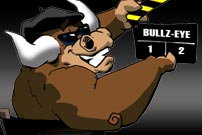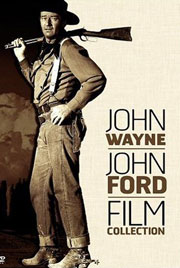 With the temperature dropping, it's time to find someone to keep you warm. Find your hookups with our online dating guide!
With the temperature dropping, it's time to find someone to keep you warm. Find your hookups with our online dating guide!
- Rated NR
- Drama
- 2006
- Buy the DVD
Reviewed by Will Harris
()
here have been few cinematic collaborations more creatively and commercially successful than the one between director John Ford and actor John Wayne; the pair teamed up on 21 films. (The only actor-director pairing that even comes close is the one between Toshiro Mifune and Akira Kurosawa, and they’re still a distant second at “only” 16 team-ups.) In addition to the recent 5-film set of some of Ford’s non-Wayne works, Warner Brothers has put together a collection of eight of the aforementioned 21 cinematic excursions.
Before you start trying to work out in your head which eight have been included in this collection, keep in mind that, because of the wonderful world of studio licensing, there’s no way the eight best Wayne/Ford collaborations are all going to be here. First and foremost, “The Quiet Man” is MIA, so shed a tear and get over it; also missing is “Rio Grande,” which means that, despite the inclusion of “Fort Apache” and “She Wore a Yellow Ribbon,” completing the so-called “Cavalry Trilogy” will require purchasing at least one more DVD. So what, then, is included?
Chronologically, first up is “Stagecoach,” a ensemble drama about a disparate bunch – an alcoholic physician, a prostitute with a heart of gold, a pregnant woman trying to reach her husband, a banker who’s stolen a pension fund…you get the idea – traveling through Indian-filled territory to get to their destination. That a fair amount of the action takes place within the confined space of the stagecoach makes for a claustrophobic viewing experience. Wayne has a sizable role, but at the time the film was made (1939), he was a far cry from the superstar he’d eventually become. In 1940’s “The Long Voyage Home” – based on several short Eugene O’Neill plays about the life of a seaman – he gets even less screen time. Incidentally, despite Wayne being just another player in the cast, “The Long Voyage Home” is the lost treasure amongst this set; it’s a dark, depressing slice of life, demonstrating that, despite the less-than-enjoyable lifestyle these men found as sailors, they came to view each other as part of a dysfunctional family…the only one most of them had. (Reportedly, O’Neill found this to be the best film adaptation of any of his works.)
“They Were Expendable” (1945) provides an account of the role of the American PT Boats in the defense of the Philippines in World War II; what’s most interesting about it within the context of this set is that the screenplay was written by Frank “Spig” Wead, a former Lieutenant Commander in the US Navy who was the subject of the 1957 biopic, “The Wings of Eagles,” where he was played by Wayne. Wead was a far cry from a perfect husband and father; his first family was the US Navy, and everyone else in his life came a distant second…though he didn’t realize how poorly he was treating them until it was almost too late. In addition to providing Wayne with one of the best dramatic turns of his career, the film also has a great supporting performance by Dan Dailey, as Wead’s longtime friend, “Jughead” Carson.
The aforementioned two cavalry pictures, “Fort Apache” (1948) and “She Wore a Yellow Ribbon” (1949), give a nice picture of military life on the open range, where Indian attacks were a regular part of life. Less impressive overall, though still not bad, is “3 Godfathers” (1948), where Wayne, Pedro Armindariz, and Harry Carey, Jr., play thieves who happen across a dying mother and promise her on her deathbed that they will take her infant child across the desert to safety; it’s a bit heavyhanded and full of religious imagery (the Three Wise Men and the baby Jesus, anyone?), but, taken in the right context, it makes for a pleasant enough holiday film.
The king of this set – no surprise to anyone who’s ever seen it – is 1959’s “The Searchers.” The cinematography alone would make it a must-see, painting as it does a breathtakingly gorgeous portrait of the American Southwest, but those who haven’t seen it may be shocked at how dark the film is. Wayne is Ethan Edwards, an ex-Confederate who returns home from the Indian wars to find that his niece – well, more or less; you get the impression there are quotation marks around his title of “uncle” – has been kidnapped by the Comanches; although the girl’s brother (Jeffrey Hunter) is on a quest to bring her home alive, Ethan has a different idea about how to handle the situation if and when they find her. This is arguably the single best collaboration between Ford and Wayne; though they would work together again, there was nowhere to go but downhill.
DVD Review:
Appropriately, the disc that’s most tricked out is “The Searchers,” which has one disc for the film (with an intro by Wayne’s son, Patrick, and audio commentary by Peter Bogdanovich) and one for the special features, which include a pair of documentaries and many on-set photos. It also comes with reproductions of the original press book for the film, many memos and documents relating to the film, and the comic book adaptation that was done by Dell Comics, as well as 10 postcards. “Stagecoach” is also a 2-disc set, including commentary, documentaries, an “American Masters” program on Ford, and a radio adaptation of the story – starring Randolph Scott – that was done at the time. Both “The Long Voyage Home” and “Fort Apache” have unique featurettes as well, and “She Wore a Yellow Ribbon” contains some of John Ford’s home movies. The remaining films only include their original trailers.
You can follow us on Twitter and Facebook for content updates. Also, sign up for our email list for weekly updates and check us out on Google+ as well.











